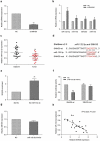LncRNA SNHG5 affects cell proliferation, metastasis and migration of colorectal cancer through regulating miR-132-3p/CREB5
- PMID: 30395767
- PMCID: PMC6422517
- DOI: 10.1080/15384047.2018.1537579
LncRNA SNHG5 affects cell proliferation, metastasis and migration of colorectal cancer through regulating miR-132-3p/CREB5
Abstract
We aimed at the effects of long non-coding RNA (lncRNA) SNHG5 on proliferation, metastasis and migration of colorectal cancer (CRC) cells. We also investigated regulatory relationships among miR-132-3p, SNHG5 and CREB5 and their roles in CRC. 25 pairs of samples containing CRC tissues and matched para-tumor tissues were obtained to examine SNHG5, miR-132-3p and CREB5 expression by qRT-PCR or Western blot. The targeted relationship between miR-132-3p and SNHG5 or CREB5 was confirmed by dual luciferase report assay as well as RNA pull down assay. The expression of SNHG5, miR-132-3p and CREB5 in CRC cells were regulated by cell transfection. CRC cellular proliferation was assayed by CCK-8 and meanwhile flow cytometry was adopted to observe apoptosis. Metastasis and migration of CRC cells were determined respectively by means of Transwell assay and scratch test. The effects of SNHG5 on CRC were researched in vivo, too. SNHG5 or CREB5 was up-regulated in CRC tissues and cells, whereas miR-132-3p was down-regulated. Overexpression of SNHG5 and CREB5 resulted in the enhancement of proliferation, metastasis, migration and the inhibition of apoptosis in CRC cells, while miR-132-3p led to the opposite result. LncRNA SNHG5 promoted proliferation, migration and metastasis of CRC cells but inhibited apoptosis by modulating miR-132-3p/CERB5.
Keywords: LncRNA SNHG5; biomarker; colorectal cancer; genetics; miR-132-3p; proliferation.
Figures









Similar articles
-
CREB5 promotes invasiveness and metastasis in colorectal cancer by directly activating MET.J Exp Clin Cancer Res. 2020 Aug 25;39(1):168. doi: 10.1186/s13046-020-01673-0. J Exp Clin Cancer Res. 2020. PMID: 32843066 Free PMC article.
-
LncRNA-SNHG15 enhances cell proliferation in colorectal cancer by inhibiting miR-338-3p.Cancer Med. 2019 May;8(5):2404-2413. doi: 10.1002/cam4.2105. Epub 2019 Apr 3. Cancer Med. 2019. PMID: 30945457 Free PMC article.
-
Long noncoding RNA RP11-757G1.5 sponges miR-139-5p and upregulates YAP1 thereby promoting the proliferation and liver, spleen metastasis of colorectal cancer.J Exp Clin Cancer Res. 2020 Oct 6;39(1):207. doi: 10.1186/s13046-020-01717-5. J Exp Clin Cancer Res. 2020. PMID: 33023613 Free PMC article.
-
Mechanisms of long non-coding RNA function in colorectal cancer tumorigenesis.Asia Pac J Clin Oncol. 2021 Feb;17(1):7-23. doi: 10.1111/ajco.13452. Epub 2020 Sep 24. Asia Pac J Clin Oncol. 2021. PMID: 32970938 Review.
-
MiR-29a-3p: a potential biomarker and therapeutic target in colorectal cancer.Clin Transl Oncol. 2023 Mar;25(3):563-577. doi: 10.1007/s12094-022-02978-6. Epub 2022 Nov 10. Clin Transl Oncol. 2023. PMID: 36355327 Free PMC article. Review.
Cited by
-
The new horizon of liquid biopsy in sarcoma: the potential utility of circulating tumor nucleic acids.J Cancer. 2020 Jul 9;11(18):5293-5308. doi: 10.7150/jca.42816. eCollection 2020. J Cancer. 2020. PMID: 32742476 Free PMC article. Review.
-
Down-regulation of SLC25A20 promotes hepatocellular carcinoma growth and metastasis through suppression of fatty-acid oxidation.Cell Death Dis. 2021 Apr 6;12(4):361. doi: 10.1038/s41419-021-03648-1. Cell Death Dis. 2021. PMID: 33824298 Free PMC article.
-
Cancer-associated fibroblasts facilitate premetastatic niche formation through lncRNA SNHG5-mediated angiogenesis and vascular permeability in breast cancer.Theranostics. 2022 Oct 17;12(17):7351-7370. doi: 10.7150/thno.74753. eCollection 2022. Theranostics. 2022. PMID: 36438499 Free PMC article.
-
The outstanding role of miR-132-3p in carcinogenesis of solid tumors.Hum Cell. 2021 Jul;34(4):1051-1065. doi: 10.1007/s13577-021-00544-w. Epub 2021 May 17. Hum Cell. 2021. PMID: 33997944 Review.
-
Circular RNA circVAPA knockdown suppresses colorectal cancer cell growth process by regulating miR-125a/CREB5 axis.Cancer Cell Int. 2020 Mar 30;20:103. doi: 10.1186/s12935-020-01178-y. eCollection 2020. Cancer Cell Int. 2020. PMID: 32256212 Free PMC article.
References
MeSH terms
Substances
LinkOut - more resources
Full Text Sources
Medical
